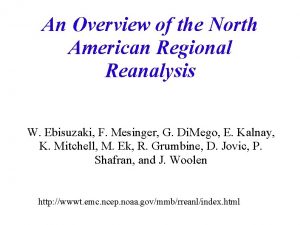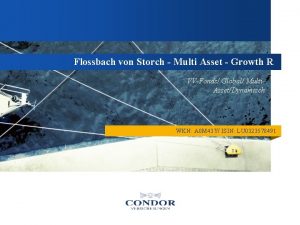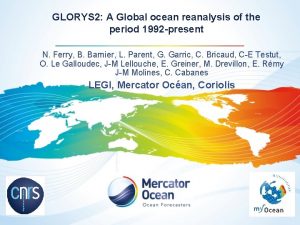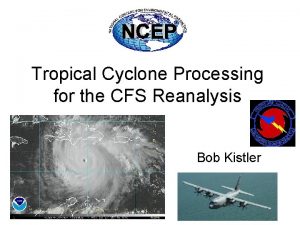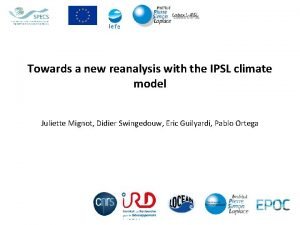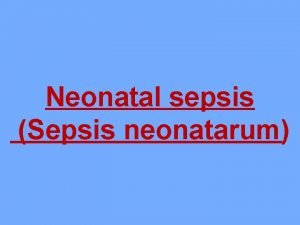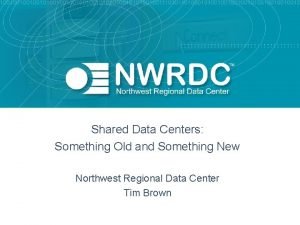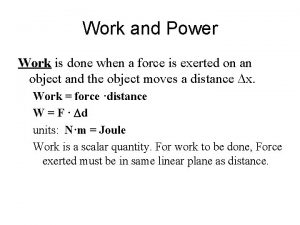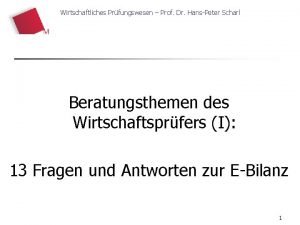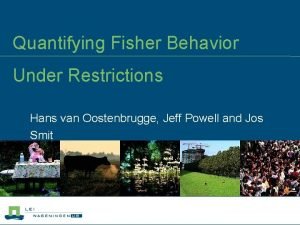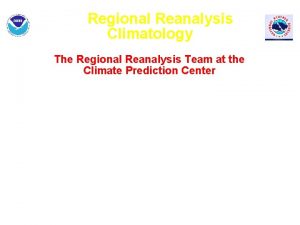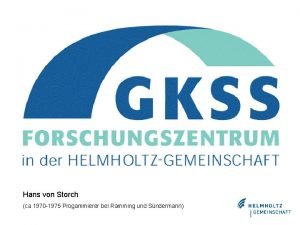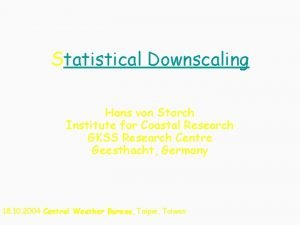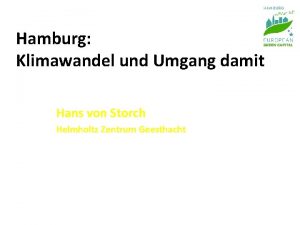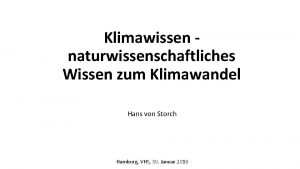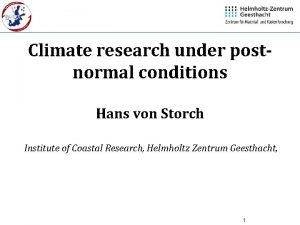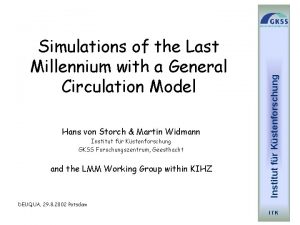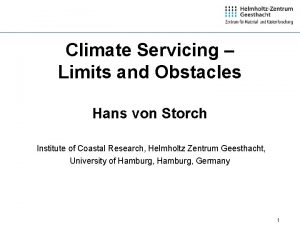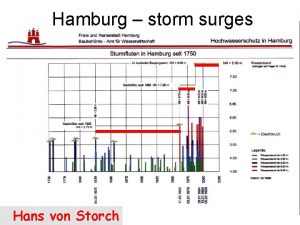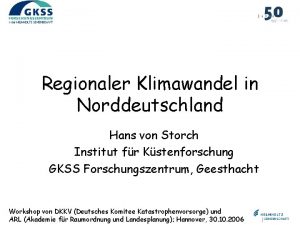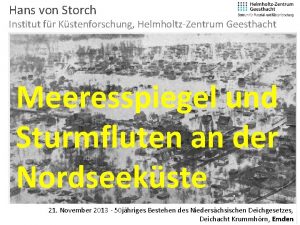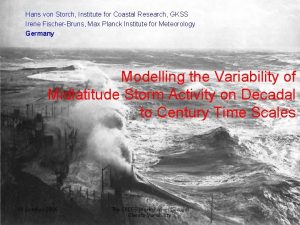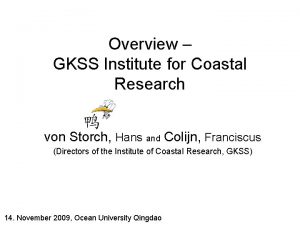Regional reanalysis without regional data VON STORCH Hans























![significant wave height [days] wave direction [days] Red: buoy, yellow: radar, blue: wave model significant wave height [days] wave direction [days] Red: buoy, yellow: radar, blue: wave model](https://slidetodoc.com/presentation_image/3241b820520636599e920953d0f7501f/image-24.jpg)





- Slides: 29

Regional re-analysis without regional data VON STORCH Hans Institute of Coastal Research, Helmholtz Zentrum Geesthacht, Germany with material of 李德磊 IOCAS, Qingdao 29 September 2016 - NUIST, 南京 (Nanjing)

VON STORCH Hans 1. 2. 3. 4. 5. Climate researcher (in the field since 1971) Coastal climate (storms, storm surges, waves; North and Baltic Sea, North Atlantic, Yellow Sea); statistical analysis Director emeritus of the Institute of Coastal Research of the Helmholtz Zentrum Geesthacht, Germany Professor at Universität Hamburg Guest professor at 中国海洋大学

Overview 1. Spectral nudging approach for constraining regional modelling - Improved representation of medium scale variability - Constructing a homogeneous regional re-analysis. 2. Improved representation in coastal regions: - variability at medium scales. - sub-synoptic phenomena (e. g. , polar lows) - forcing fields for impact models (ocean waves, storm surges) 3. The regional reanalysis Coast. Dat for governmental agencies, commercial companies and the public/media

Climate and downscaling • • • The genesis of „regional“ climate my be conceptualized (only at midlatitudes? ) as R = f(L, Φs) with L = larger scale climate, R = smaller scale climate, Φs = physiographic detail at smaller scale (mountains, cities, coastlines etc. ). Climate models generate numbers for all scales, beginning at the grid resolution. The smallest of these scales are heavily disturbed because of an insufficient representation of the small-scale physiography but also because of the abrupt truncation at the grid resolution. The largest scales in global re-analysis may be in many cases considered as well and homogeneously described. The smallest scales are considered less realistic and subject to inhomogeneities (sensitive to changes of observational local data availability).

Maximum resolution Grid point resolution Skillfully represented scales Insufficiently represented scales Grid point resolution Maximum resolution Regional Analysis Skillfully represented scales Constraining Global Analysis Insufficiently represented scales Added value Downscaling using R = f(L, Φs) processes the reliably and homogeneously described large scales L. The constraining may be implemented by spectral nudging into a regional or even global dynamical model. (von Storch, H. Langenberg and F. Feser, 2000: A spectral nudging technique for dynamical downscaling purposes. Mon. Wea. Rev. 128: 3664 -3673)

Constraining of large scales global Pattern correlation coefficients for meridional wind at 500 h. Pa between the driving global reanalysis and the • RCM-output with standard forcing via the lateral boundaries and the • RCM-output nudging with spectral regional

Regional re-analysis • without regional data. • exploiting the presence of a “downscaling” situation L > R • and the availability of long, homogeneous re-analysis of “large-scale” dynamics L. • Added value is in R, i. e. in the regional detail, which results from L and the regional physiographic detail (such as coastlines, mountains) • Done for - Europe (including hydrodynamic of marginal seas; COASTDAT) - China (Yellow Sea region, see 李德磊), - Central Siberia and Southern Atlantic, - nd recently the Globe.

A 5 -year simulation 2001 -2005 for the region of South China李德磊, pers. Comm. ) • CCLM_JRA 55: CCLM simulation driven by JRA 55 (and, alternatviely ERA-I) reanalysis dataset (7 km, 2001 -2005) is compared to APHRODITE daily precipitation and temperature datasets with high-resolution grids for Asia (0. 25°) Domain-averaged seasonal climatology and temporal evolution (annual cycle removed) of surface temperature and total precipitation:

precip amounts 2 m temperature JJA % DJF % CCLM_JRA 55 bias relative to observation for daily precip amounts and mean daily mean temperature in summer and in winter K

precip amounts JJA 2 m temperature % DJF Correlations between CCLM_JRA 55 model data and observations for daily precip amounts and mean daily mean temperature in summer and in winter

precip amounts 2 m temperature JJA % DJF mm Root mean square errors between simulations and observation dataset for daily precip amounts and mean daily mean temperature in summer and in winter K

Improved presentation of in coastal regions • ERA-I-driven multidecadal simulation with RCM CCLM over the Bohai Sea and the Yellow Sea region (李德磊, 2015) • Grid resolution: 0. 06 o • Material by 李德磊

Model setups and datasets Long-term simulation Forcing dataset COSMO-CLM (CCLM): 1979. 012013. 12, spectral nudging ERA-Interim (1979 – 2013, ~ 80 km, 6 hourly) Physical Parameterization Tiedtke convection scheme and Charnock-formula for RL Resolution Spatial: 0. 0625° (~7 km), 40 vertical layers, hourly output Grid Rotated coordinate system 168 x 190 Land Station Data 67 land surface stations, 3 hourly (Had. ISD) Marine Station Data 7 stations, including 3 offshore stations and 4 coastal stations (NCDC and KMA) Satellite Data Quik. SCAT L 2 B in 12. 5 km swath data (QSCAT, 1999. 122009. 11)

CCLM compared with QSCAT grid data (7 km) Ø Mean wind speed: 6. 5 – 9 m/s Ø Negative Bias: around -1 m/s Ø Correlation coeff. : 0. 6 - 0. 85 (m/s) Ø RMSE: 1. 5 – 3. 0 m/s Ø In some coastal areas : larger bias, lower correlation coeff. , larger RMSE 14 (m/s)

Is there an added value? (CCLM, ERA-I, BSS obs: QSCAT > 3 m/s) et al. 2011) BSS (CCLM, ref: ERA-I, obs: QSCAT > 10. 8 m/s) Modified. BSS Brier Skillref: Score: (Winterfeldt SEO BSS: [-1, 1] BSS =1, Perfect model BSS > 0, added value (improvement) BSS < 0, no added value IEO Ø Added value (positive BSS) in coastal areas for wind speed > 3 m/s Ø Areas with added value are larger for strong wind speed (right) than for wind speed > 3 15 m/s (left)

Comparison of CCLM/ERA-I and in-situ data: offshore station (IEO) CCLM ERA-I qq-plot Ø No improvement of CCLM wind speed (left) relative to ERA-I wind speed (right) at offshore station IEO

Comparison of CCLM/ERA-I and in-situ data : coastal station (SEO) CCLM ERA-I qq-plot Ø CCLM wind speed (left) is in better agreement with observations than ERA-I wind speed (right) at coastal station SEO 17

Seasonality of water-regionaveraged wind speed Ø CCLM and ERA-I wind speeds underestimate QSCAT observations in all seasons Ø More improvement of CCLM wind speed relative to ERA-I wind speed in summer 18 than in other seasons especially in winter

Climatological mean of annual extreme surface wind speed (99%-iles) (m/s) Ø Similar distribution pattern, more spatial variability and detail in CCLM wind field Ø CCLM: lower values over mountainous areas and larger values over some water areas 19 Ø CCLM: better in agreement with observations

Generating additional regional dynamical detail • NCEP-driven multidecadal simulation with RCM CLM over North Pacific (�� et al. , 2012, 2013, 2014) • Grid resolution: about 0. 4 o • Employing spectral nudging (wind above 850 h. Pa, for scales > 800 km) • Simulation of sub-synoptic phenomena • Polar lows in the Northern North Pacific

North Pacific Polar Lows (�� et al. , 2012, 2013 and 2014) North Pacific Polar Low on 7 March 1977 NOAA-5 infrared satellite image at 09: 58 UTC 7 th March 1977

Annual frequency of past polar lows in the North Pacific Number of detected Polar Lows in the North Pacific per Polar Low season (PLS; October to April). The trend from 62 PLSs, from 1948/1949 to 2009/2010, amounts to 0. 17 cases/year. �� et al. , 2013

Improved representation of forcing fields for impact models NCEP-driven multidecadal simulation with RCM REMO in Europe Grid resolution: 0. 5 o Employing spectral nudging (wind above 850 h. Pa, for scales > 800 km) 1948 -2010 simulation Wind air pressure used to drive hydrodynamical models for describing currents and sea level • Wind used to drive models of the statistics of surface waves (ocean waves) in coastal seas (North Sea). • • •
![significant wave height days wave direction days Red buoy yellow radar blue wave model significant wave height [days] wave direction [days] Red: buoy, yellow: radar, blue: wave model](https://slidetodoc.com/presentation_image/3241b820520636599e920953d0f7501f/image-24.jpg)
significant wave height [days] wave direction [days] Red: buoy, yellow: radar, blue: wave model run with REMO winds Gerd Gayer, pers. comm. , 2001

Interannual variability of mean water levels (Weisse and Plüß 2006) Annual mean winter high waters Cuxhaven red – reconstruction, black – observations

The Coast. Dat-effort at the Institute for Coastal Research@HZG Ø Long-term, high-resolution reconstructions (60 years) of present and recent developments of weather related phenomena in coastal regions as well as scenarios of future developments (100 years) Ø Northeast Atlantic and northern Europe. Ø Assessment of changes in storms, ocean waves, storm surges, currents and regional transport of anthropogenic substances. Applications Ø many authorities with responsibilities for different aspects of the German coasts Ø economic applications by engineering companies (off-shore wind potentials and risks) and shipbuilding company Ø Public information www. coastdat. de Integration area used in HZG reconstruction and regional scenarios

Changing significant wave height, 1958 -2002 waves wind Weisse, pers. comm. Yantai, 18 June 2007 Page 27 waves

Some applications of - Ship design - Navigational safety - Offshore wind - Interpretation of measurements - Oils spill risk and chronic oil pollution - Ocean energy - Scenarios of storm surge conditions - Scenarios of future wave conditions Currents Power [W/m 2] Weisse, pers. comm. Wave Energy Flux [k. W/m]

Conclusion … • Dynamical downscaling (R = f(L, Φs)) works … - Large scales are hardly affected but smaller scales are more realistically described in heterogeneous regions (coasts, mountains) • Downscaling allows the generation of homogeneous data sets i. e. , a regional re-analysis with uniform quality (across time). • Added value in describing medium scale phenomena – such as wind storms • Added value in generating regional impact variables, such as wind for storm surges and ocean waves. • Several such regional re-analysis has been done, among them for the region of the Bo Hai and the Huang Hai on a 7 -km grid by 李 德磊.
 North american regional reanalysis
North american regional reanalysis Flossbach von storch - multi asset - growth r
Flossbach von storch - multi asset - growth r Glorys reanalysis
Glorys reanalysis Tcvitals
Tcvitals Reanalysis
Reanalysis Storch infection
Storch infection Storch infections
Storch infections Storch infections
Storch infections Kterou knihu nenapsal eduard štorch
Kterou knihu nenapsal eduard štorch General classes of victims by hans von hentig
General classes of victims by hans von hentig Kurshalter
Kurshalter Erasmus von rotterdam beeinflusst von
Erasmus von rotterdam beeinflusst von Who’s the author of “without title”?
Who’s the author of “without title”? Without a title poem
Without a title poem Without rush without engines poetic device
Without rush without engines poetic device Nwrdc fsu
Nwrdc fsu Free operant data sheet
Free operant data sheet Work vs power
Work vs power Sheila has just arrived at the airport and is dragging
Sheila has just arrived at the airport and is dragging Hans peter scharl
Hans peter scharl Hans blaauwbroek
Hans blaauwbroek Cytolyische vaginose
Cytolyische vaginose Cum
Cum Fefferling
Fefferling Zacharias janssen
Zacharias janssen Hans christian oersted experiment
Hans christian oersted experiment Fueled by marcie hans
Fueled by marcie hans Hans mustermann
Hans mustermann Hans van oostenbrugge
Hans van oostenbrugge Hans and sybil eysenck contribution to psychology
Hans and sybil eysenck contribution to psychology
